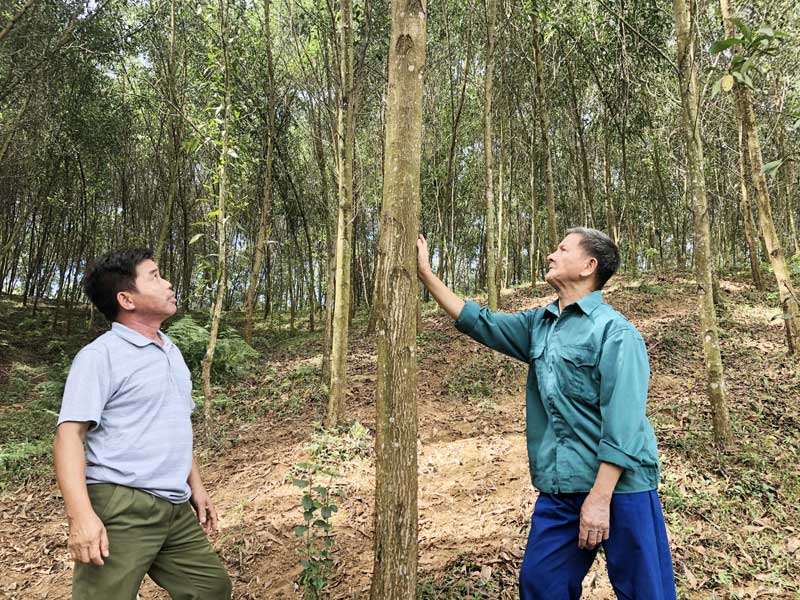
(HBO) – In 2016, the agriculture extension centre of Hoa Binh province launched a project on developing a model for synchronously applying technical advances to planting fast-growing large-timber forests. This project covered 38ha of land with 20 households participating. After four years of implementation, up to 95-98 percent of the trees planted under this project have survived with even growth, height of 10-12m and trunks 15-20cm in diameter.
 Bui
Van Danh (right), a resident in Bin hamlet of Tu Ne commune (Tan Lac district),
shares experience in planting fast-growing large-timber forests with other
locals.
Bui
Van Danh (right), a resident in Bin hamlet of Tu Ne commune (Tan Lac district),
shares experience in planting fast-growing large-timber forests with other
locals.
Planting large-timber forests is useful for
saving seedling and care-related expenses while improving economic efficiency
on a same area of cultivation (large-timber forests generate value three-four
times higher than that of small-timber ones) and minimising pests and diseases
on trees as well as land degradation.
To carry out the project in Tan Lac, the
provincial agriculture extension centre provided seedlings for local
households. The chosen varieties are BV10, BV16 and BV32 of Acacia hybrid.
Tan Lac district boasts huge potential for
forestry development. The district has zoned more than 33,300ha of land for
forestry, including over 25,000ha already under forest.
However, locals have yet to fully capitalise on
the forestry development potential but just exploited young and small trees for
raw materials and wood chips. Besides, their cultivation practices are out of
date and mainly focus on extensive farming, instead of intensive farming and
improving forest productivity and quality.
Basing on the provincial agriculture and rural
development’s policy of converting small-timber forests into large-timber ones
for more profit, authorities of Tan Lac have boosted communications to
encourage people to adopt growing large-timber forests while sending staff from
the district’s agricultural services centre and agriculture extension workers
of local communes to monitor forest development.
As a result, local residents have gradually
realised the importance of the intensive farming of large-timber forests and
changed their practices. After nearly four years of project implementation,
though the planted trees haven’t matured enough for exploitation, experts and
locals said they have seen initial encouraging outcomes in planting
fast-growing large-timber forests and believe that the practice will become
profitable and help protect the environment./.
The Department of Education and Training of Hoa Binh province held a conference on March 18 to review the performance of the "Safe and Happy School" Project and set out tasks for 2025. The project, funded by the Taiwan Fund for Children and Families (TFCF), aims to create a safe, inclusive, and supportive learning environment for students. The event saw the attendance of representatives from the TFCF and 26 beneficiary schools.
With over 70% of their workers being women, trade unions across industrial parks (IPs) in Hoa Binh have been actively safeguarding their legal rights and interests while implementing initiatives to improve their income and well-being.
In recent years, the Hoa Binh provincial General Hospital has continuously innovated itself and improved the quality of medical services to meet the increasing needs of local people. With substantial investments in infrastructure and modern equipment, along with a team of highly qualified doctors and nurses, the hospital has gradually established itself as one of the leading medical units in the Northwestern region and a trusted destination for healthcare for people inside and outside the province.
From mastering the fundamentals of programming to achieving national recognition, the Programming Club of the Le Van Tam Primary School (STAR LVT28) in Hoa Binh city has made remarkable strides in the field of robotics.
The Ho Chi Minh Communist Youth Union Committee and the Vietnam Youth Federation chapter of Hoa Binh province organised a programme on March 12 to launch the "Digital Literacy" movement and an online quiz on the resolutions of the Vietnam Youth Federation congresses at all levels, as well as the Politburo's Resolution No. 57-NQ/TW on breakthroughs in the development of science, technology, innovation, and national digital transformation.
As climate change grows more unpredictable, the development of production forests has become essential - not just for economic growth, but for safeguarding the environment and maintaining ecosystem balance. By boosting local incomes, curbing natural disasters, preventing soil erosion, and protecting water resources, these forests play a crucial role in sustainable development.



 Bui
Van Danh (right), a resident in Bin hamlet of Tu Ne commune (Tan Lac district),
shares experience in planting fast-growing large-timber forests with other
locals.
Bui
Van Danh (right), a resident in Bin hamlet of Tu Ne commune (Tan Lac district),
shares experience in planting fast-growing large-timber forests with other
locals.